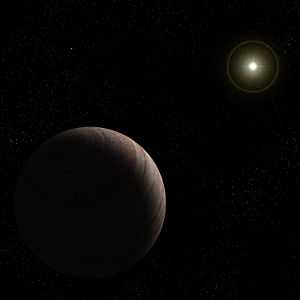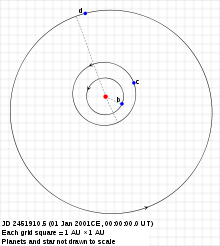47 Ursae Majoris b
| Extrasolar planet | List of extrasolar planets | |
|---|---|---|
 | ||
| Parent star | ||
| Star | 47 Ursae Majoris | |
| Constellation | Ursa Major | |
| Right ascension | (α) | 10h 59m 28.0s |
| Declination | (δ) | +40° 25′ 49″ |
| Apparent magnitude | (mV) | 5.03 |
| Distance | 45.9 ly (14.06 pc) | |
| Spectral type | G1V | |
| Mass | (m) | 1.08 M☉ |
| Radius | (r) | 1.172 ± 0.111 R☉ |
| Temperature | (T) | 5887 ± 3.8 K |
| Metallicity | [Fe/H] | 0.04 |
| Age | 6.03 Gyr | |
| Orbital elements | ||
| Semimajor axis | (a) | 2.10 ± 0.02[1] AU (~314 Gm) |
| ~14.9 mas | ||
| Periastron | (q) | 2.03 ± 0.05 AU (~304 Gm) |
| Apastron | (Q) | 2.17 ± 0.05 AU (~324 Gm) |
| Eccentricity | (e) | 0.032 ± 0.014[1] |
| Orbital period | (P) | 1078 ± 2[1] d (~2.95 y) |
| Orbital speed | (υ) | 21.3 ± 0.3 km/s |
| Argument of periastron |
(ω) | 334 ± 23[1]° |
| Time of periastron | (T0) | 2,451,917+63 −76[1] JD |
| Semi-amplitude | (K) | 49.00 ± 0.87[2] m/s |
| Physical characteristics | ||
| Minimum mass | (m sin i) | 2.53+0.07 −0.06[1] MJ |
| Stellar flux | (F⊙) | 0.33 ⊕ |
| Temperature | (T) | 200 |
| Discovery information | ||
| Discovery date | 17 January 1996 | |
| Discoverer(s) | Marcy and Butler et al. | |
| Discovery method | Doppler spectroscopy | |
| Discovery site | ||
| Discovery status | Confirmed | |
| Other designations | ||
| Database references | ||
| Extrasolar Planets Encyclopaedia | data | |
| SIMBAD | data | |
| Exoplanet Archive | data | |
| Open Exoplanet Catalogue | data | |
47 Ursae Majoris b (sometimes abbreviated 47 Uma b) is an extrasolar planet approximately 46 light-years from Earth in the constellation of Ursa Major. The planet was discovered located in a long-period orbit around the star 47 Ursae Majoris in January 1996 and as of 2011 is the innermost of three known planets in its planetary system. It has a mass at least 2.53 times that of Jupiter.
Discovery
Like the majority of known extrasolar planets, 47 Ursae Majoris b was discovered by detecting the changes in its star's radial velocity as the planet's gravity pulls the star around. This was achieved by observing the Doppler shift of the spectrum of 47 Ursae Majoris. After the discovery of the first extrasolar planet around a Sun-like star, 51 Pegasi b, astronomers Geoffrey Marcy and R. Paul Butler searched through their observational data for signs of extrasolar planets and soon discovered two: 47 Ursae Majoris b and 70 Virginis b. The discovery of 47 Ursae Majoris b was announced in 1996.[5]
Orbit and mass

47 Ursae Majoris b orbits at a distance of 2.10 AU from its star, taking 1,078 days or 2.95 years to complete a revolution.[1] It was the first long-period planet around a main sequence star to be discovered. Unlike the majority of known long-period extrasolar planets, the eccentricity of the orbit of 47 Ursae Majoris b is low.
A limitation of the radial velocity method used to detect 47 Ursae Majoris b is that only a lower limit on the planet's mass can be obtained. Preliminary astrometric measurements made by the Hipparcos satellite suggest the planet's orbit is inclined at an angle of 63.1° to the plane of the sky, which would imply a true mass 12% greater than the lower limit determined by radial velocity measurements.[6] However, subsequent investigation of the data reduction techniques used suggests that the Hipparcos measurements are not precise enough to adequately characterise the orbits of substellar companions, and the true inclination of the orbit (and hence the true mass) are regarded as unknown.[7]
Physical characteristics
Given the planet's high mass, it is likely that 47 Ursae Majoris b is a gas giant with no solid surface. Since the planet has only been detected indirectly, properties such as its radius, composition, and temperature are unknown. Due to its mass it is likely to have a surface gravity 6–8 times that of Earth. Assuming a composition similar to that of Jupiter and an environment close to chemical equilibrium, the upper atmosphere of the planet is expected to contain water clouds, as opposed to the ammonia clouds typical of Jupiter.[8]
While 47 Ursae Majoris b lies outside its star's habitable zone, its gravitational influence would disrupt the orbit of planets in the outer part of the habitable zone.[9] In addition, it may have disrupted the formation of terrestrial planets and reduced the delivery of water to any inner planets in the system.[10] Therefore planets located in the habitable zone of 47 Ursae Majoris are likely to be small and dry.
It has been theorized that light reflections and infrared emissions from 47 UMa b, along with tidal influence, could warm any moons in orbit around it to be habitable, despite the planet being outside the normally accepted habitable zone.[11][12]
See also
Footnotes
- ↑ These alternative planetary designations are taken from the alternative designations of the host star, and are used in scientific papers occasionally for some exoplanets (see Milone & Wilson 2008 and Raghaven 2009). The most commonly used star designations are Bayer, Flamsteed, HD, HIP, HR, and Gliese.
References
- ↑ 1.0 1.1 1.2 1.3 1.4 1.5 1.6 P. C. Gregory, D. A. Fischer (2010). "A Bayesian periodogram finds evidence for three planets in 47 Ursae Majoris". Monthly Notices of the Royal Astronomical Society 403 (2): 731. arXiv:1003.5549. Bibcode:2010MNRAS.403..731G. doi:10.1111/j.1365-2966.2009.16233.x.
- ↑ "Planets Table". Catalog of Nearby Exoplanets. Archived from the original on 21 September 2008. Retrieved 2008-10-04.
- ↑ D. Raghavan (2009). "A Survey of Stellar Families: Multiplicity of Solar-type Stars" (PDF). PhD Thesis (Georgia State University): 224–226.
- ↑ E. F. Milone, W. J. F. Wilson (2008). Solar System Astrophysics: Planetary Atmospheres and the Outer Solar. Solar System Astrophysics 2. Springer. pp. xv, 328, 339, 349. ISBN 0-387-73153-9.
- ↑ R. P. Butler et al. (1996). "A Planet Orbiting 47 Ursae Majoris". Astrophysical Journal Letters 464 (2): L153–L156. Bibcode:1996ApJ...464L.153B. doi:10.1086/310102.
- ↑ I. Han, D. C. Black, G. Gatewood (2001). "Preliminary Astrometric Masses for Proposed Extrasolar Planetary Companions". Astrophysical Journal Letters 548 (1): L57–L60. Bibcode:2001ApJ...548L..57H. doi:10.1086/318927.
- ↑ D. Pourbaix, F. Arenou (2001). "Screening the Hipparcos-based astrometric orbits of sub-stellar objects". Astronomy and Astrophysics 372 (3): 935–944. arXiv:astro-ph/0104412. Bibcode:2001A&A...372..935P. doi:10.1051/0004-6361:20010597.
- ↑ D. Sudarsky et al. (2000). "Albedo and Reflection Spectra of Extrasolar Giant Planets". Astrophysical Journal 538 (2): 885–903. arXiv:astro-ph/9910504. Bibcode:2000ApJ...538..885S. doi:10.1086/309160.
- ↑ B. Jones et al. (2005). "Prospects for Habitable "Earths" in Known Exoplanetary Systems". Astrophysical Journal 622 (2): 1091–1101. arXiv:astro-ph/0503178. Bibcode:2005ApJ...622.1091J. doi:10.1086/428108.
- ↑ S. Raymond (2006). "The Search for other Earths: limits on the giant planet orbits that allow habitable terrestrial planets to form". Astrophysical Journal Letters 643 (2): L131–134. arXiv:astro-ph/0605136. Bibcode:2006ApJ...643L.131R. doi:10.1086/505596.
- ↑ "In Search Of Habitable Moons". Pennsylvania State University. Retrieved 2009-05-05.
- ↑ "Stellar Data for 47 Ursa Majoris". Archived from the original on 13 May 2009. Retrieved 2009-05-05.
External links
- "47 Ursae Majoris". SolStation. Archived from the original on 2008-05-11. Retrieved 2008-06-26.
- "47 Ursae Majoris b". Planet Quest. Retrieved 2013-10-05.
- "47 Ursae Majoris b". Exoplanet Data Explorer. Retrieved 2013-10-05.
| ||||||||||
Coordinates: ![]() 10h 59m 28.0s, +40° 25′ 49″
10h 59m 28.0s, +40° 25′ 49″
| ||||||||||||||||||||||||||||||||||||||||||||||||||||||||||||||||||||||||||||||||